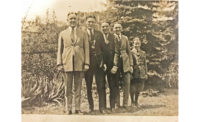When SDM put out its inaugural issue in January, 1971, the security industry as we know it today did not exist. There were no trade shows, no systems integrators, no DIY systems and no reliable publications to turn to for information.
Les Gold, SDM’s longtime legal columnist and a pioneer in the industry, remembers when Ray Farber first walked into his office to tell him about an idea for a trade show for the industry, which would eventually be known as ISC West. Soon after, Farber started what is known today as the Security Industry Association (SIA), and a publication called Security Distributing & Marketing — now SDM.
There was no stopping the advancement of the industry after that. It was off to the races, and a new era of security emerged. Editors wrote about ultrasonic and microwave detectors, alarm controls and tape dialers, emerging UL standards and the activities of new industry organizations such as the NBFAA (now ESA).
The Early Years
In 1979, Security Distributing & Marketing was acquired by Cahners Publishing, and Susan Whitehurst started as senior editor of the magazine (she eventually became the magazine’s publisher for many years).
“It was a time of real growth and the use of more advanced electronics, both in the security systems that were being sold, installed and monitored, and in the operations of the companies,” Whitehurst recalls. “The people who were using security systems for protection had traditionally been business owners; and at that time, the idea of the residential use of security systems was really starting to take off from the small number of the very wealthy and security-conscious, to a broader spectrum of people and businesses.”
The birth of the digital communicator also brought a great deal of change to the industry. SDM’s Security Networkings Columnist David Engebretson was working in security sales at the time, and remembers how disruptive the technology was.
“In the old days, if you didn’t have a central station, you weren’t an alarm company, and the central stations dealt with direct wires,” Engebretson says. “Then came the digital communicator which really revolutionized the business. Now I don’t need my own central station — I can have Emergency24 do it. This changed the way dealers did business, and soon after came the big alarm companies giving away alarm systems, or selling them for $50.”
Laura Stepanek, who just retired from her role as editor of SDM in 2020, first joined the staff as a production editor in 1984. She notes how much the process of producing the magazine has changed since the early days of the magazine.
“It was extremely different — the production process was very intensive, and a lot of my day was spent on that initially,” Stepanek says. “One of my first jobs was copy editing stories written by the more senior editors, and in addition to correcting spelling and grammar, I marked up the pages for typesetting. In the margins of the page, I had to note which font to use. Sometimes I actually retyped the stories if they were too messy with edits or notes. And this was all done by hand or typewriter, no computers.”
Kent Beaver, SDM regional sales manager for the Western U.S. and Canada, was working for a start-up publication called Access Control in 1985, and says the process of selling advertisements was very different as well.
“It was a different world selling ads back in the ’80s,” Beaver says. “Companies did not have integrated solutions and only sold components. Most companies were run by engineers, and many didn’t have a marketing department. It was a much smaller market 30-plus years ago.”
Turning Around a Bad Reputation
One of the main issues the security industry was battling in the ’70s and ’80s was a perceived lack of professionalism. Stepanek says there were a lot of security dealers looking to make a quick buck, known as trunk slammers.
“They weren’t trained or educated, they bought inexpensive equipment, they installed it without any knowledge of how to wire things properly, and when these systems ultimately malfunctioned, the dealers were nowhere to be found,” Stepanek says. “They were giving the industry a bad reputation.”
Leaders in the industry took the matter into their own hands, and ultimately, the National Training School (NTS) was born, with the goal of educating security dealers. Whitehurst had the entire SDM staff take the first Alarm Technician 1 course, so they could all be knowledgeable on the technologies they wrote about.
“Initially, there were very, very low barriers to entry in the industry,” Stepanek says. “Anyone could start up a company, and there was no guarantee that they knew what they were doing. So the whole aim of the ’80s of making the industry more professional was to raise those barriers and make it more difficult to operate in the industry, while making sure the customer would be treated fairly, and weeding out the trunk slammers.”
SDM helped add legitimacy to the industry by being the first to collect data and do analyses on security companies.
“That was a big thing we wanted to accomplish — to have our readers not only read the magazine, but actually use the magazine — and part of that was collecting data, doing analysis and combining that with a narrative,” Whitehurst says. “There hadn’t been any real data developed for the industry or by the industry at that time, so SDM was really an instigator of that, generating new numbers that would be useful and accurate to give the industry more understanding of business growth and market opportunities, and looking at some of the new technology that was able to help companies grow and expand their offerings.”
And so, SDM’s first annual Industry Forecast Study (link to current one in this issue) was published in 1982. The first SDM 100 (link: https://www.sdmmag.com/SDM100Report) came in 1991, and the Top Systems Integrators Report (link: https://www.sdmmag.com/Top-Systems-Integrators-Report) in 1996.
Stepanek remembers the impact the first SDM 100 had on the industry.
“Because of the home security boom in the mid-80’s, it attracted a lot of attention to the industry from the financial world,” Stepanek says. “We were receiving requests from investors who wanted to know about the industry. They saw a lot of companies were growing really quickly, and they wanted to know more about the business, and there was absolutely no information before.”
Even outside of these data-based stories, the editorial team worked to promote and educate the industry, remembers former managing editor Deborah O’Mara, who now runs DLO Communications, a public relations company for the physical security and technology sectors.
“Digging up dirt is not the point of a specialty trade magazine — the idea is to bring greater understanding of the industry to the public and help promote it positively,” O’Mara says. “The magazine has evolved with the industry, even perpetuating innovation. … The industry had more of a homegrown look and feel, and that was reflected in our editorial pages. It was a conversational type of publication that was a snapshot of the alarm company itself — primarily family-owned and operated firms with central monitoring stations.”
Allan Colombo started freelancing for SDM in 1986, and joined the full-time staff in 1990. He remembers his 11 years at the magazine as a highlight of his life, and recently started freelancing for the magazine again.
“SDM was very progressive,” Colombo says. “I wrote for two other industry magazines under a different name, and used my real name for SDM, because it was the bible of the industry. Writing [for SDM again] is kind of like coming back home.”
Kevin Lehan, national sales and marketing manager for EMERgency24, Des Plaines, Ill., says that SDM was integral to the national growth of the company.
“Trade publications allowed a then-regional company to expand its reach in one single vehicle,” Lehan says. “The only other way to contact those people would be to join every one of the associations and have people there. Trade magazines allowed you to touch 50,000 people, and SDM was one I always respected, from my ad agency days up until present.”
Technology Brings the Industry Into the Future
It didn’t take long for all of the hard work industry leaders were putting in to pay off. Home security systems were exploding in popularity, and businesses were investing far more in systems.
“The recession of the early ’90s emerged from a period of strong economic and jobs growth — companies were investing in security technology to provide businesses with more information to better assess and protect business continuity, while neutralizing threats to assets (people, intellectual property and physical property,” says Mark Duato, executive vice president of aftermarket solutions, ASSA ABLOY Opening Solutions Americas, New Haven, Conn. “The economic growth that followed the early recession was unprecedented, and fueled the industry exponentially.”
Brian Seemann, executive vice president of operations development at Alula, St. Paul, Minn., first entered the security world in 1995, as the director of engineering for wireless security and smart home automation at Interactive Technologies Inc.
He says he was drawn to the industry because of the innovative technology that continues to be developed.
“In the early to mid-’90s, dealers were still taking a solid day running wires, and making their living off the install labor,” Seemann says. “Rapid-install wireless sensors and the emergence of impactful interactive [technologies] pointed the industry toward the sky. These tech advancements launched this industry into the recurring revenue, lifestyle-integrated business model it is today.”
The late ’90s also brought quite a few changes to the publishing industry. The internet was born, and SDM soon had a website. This coincided with another acquisition of the magazine when the current owners, BNP Media, purchased the publication in January 2001.
Whitehurst says that BNP helped SDM get serious about its website, and that the advertisers who supported them in the move were vital.
“When we were bought by BNP, it was a big deal for us to be able to have fresh news on the website every day,” Whitehurst says. “It was a lot of fun, learning about the internet and how to develop websites and keep them fresh and useful, all while still having that monthly deadline. It was all new to us. And a number of companies that had been advertising for quite a while supported our first efforts and helped us get those websites going. That was really crucial — to have the industry’s support made such a tremendous difference.”
The emergence of the internet affected the rest of the security industry as well. Richard Sedivy, director of marketing and regulatory affairs at DoorKing, Inglewood, Calif., considers the internet to be the single biggest change the security world has dealt with.
“[The internet] has changed the way we do business, and how we manage access control — everything from a device the size of the palm of your hand,” Sedivy says.
The tragedy of 9/11 in 2001 brought an even greater focus on security, especially in the commercial market.
Frederik Nilsson, vice president of Americas at Axis Communications, Chelmsford, Mass., moved to the U.S. to focus on business development for the company right before the disaster.
“Just after I moved to the U.S., the 9/11 attacks occurred, and all of a sudden physical security was top of mind for everyone,” Nilsson says. “Our industry was a hot topic in and of itself.”
Because of the nature of the attacks, Nilsson says that technologies like facial recognition grew in popularity, which led to issues such as privacy rights.
“These issues were signs of things to come,” Nilsson says. “As an industry, we began to deal with a much more complicated world and more complex technologies that presented new ethical issues.”

Click to expand
A lot has changed in the past 50 years, both at SDM and in the industry. Here are just a few of the highlights.
New Decade, New World
Facial recognition technologies were still a highly debated issue in 2020, perhaps the year that brought the most change in SDM’s history. Laura Stepanek retired, and Karyn Hodgson took the lead as editor. Hodgson has been with the publication in some capacity since the early ’90s, and recalls many of the industry changes that shaped that decade and beyond.
“I was hired by Bill Zalud (the former Security and SDM editor who passed away in 2016, and was very influential to both magazines and the security industry.) as staff editor on the publication’s sister magazine, Security Magazine in 1992, and eventually became managing editor over both publications in 2000,” she recalls. Shortly after the magazine was acquired by BNP, Hodgson left to raise a family, but continued to freelance regularly for SDM, writing primarily about the access control technology, before returning full time in 2015 as senior editor.
“I was happy to be back in the SDM family, and excited to reconnect with industry friends and acquaintances I hadn’t seen for years,” she says. “One thing they say about this industry is people may move around a lot, but very few ever leave. There is a lot of passion about the mission and purpose this industry brings to the world and that is something that hasn’t changed in 50 years.”
The changes at SDM continued in 2020 with a new staff editor, Amanda Reed, and the move to become a fully digital publication in the industry. This plan was accelerated by the COVID-19 pandemic, which completely rocked the industry, and the world.
“The world has changed more in the last year than in the previous 20, since 9/11,” Duato says. “Getting COVID-19 behind us, developing consumer confidence and impacting economic recovery are critically important in the coming year or two. Innovation always emerges from these crises, and the 2020’s should prove that out in our industry.”
To our readers and advertisers, thank you for sticking with us for the past 50 years. Without you, there would be no need for us. Cheers to the next 50! I know we are all excited to see what the ‘new normal’ will bring.












